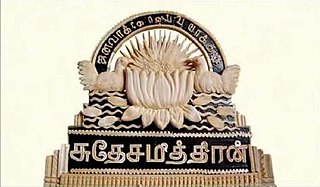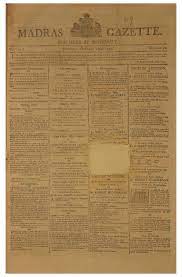
Warren Hastings was a British colonial administrator, who served as the first Governor of the Presidency of Fort William (Bengal), the head of the Supreme Council of Bengal, and so the first Governor-General of Bengal in 1772–1785. He and Robert Clive are credited with laying the foundation of the British Empire in India. He was an energetic organizer and reformer. In 1779–1784 he led forces of the East India Company against a coalition of native states and the French. Finally, the well-organized British side held its own, while France lost influence in India. In 1787, he was accused of corruption and impeached, but after a long trial acquitted in 1795. He was made a Privy Councillor in 1814.

The Hindu is an Indian English-language daily newspaper owned by The Hindu Group, headquartered in Chennai, Tamil Nadu. It began as a weekly in 1878 and became a daily in 1889. It is one of the Indian newspapers of record and the second most circulated English-language newspaper in India, after The Times of India. As of March 2018, The Hindu is published from 21 locations across 11 states of India.

Company rule in India was the rule of the British East India Company on the Indian subcontinent. This is variously taken to have commenced in 1757, after the Battle of Plassey, when the Nawab of Bengal Siraj ud-Daulah was defeated and replaced with Mir Jafar, who had the support of the East India Company; or in 1765, when the Company was granted the diwani, or the right to collect revenue, in Bengal and Bihar; or in 1773, when the Company abolished local rule (Nizamat) in Bengal and established a capital in Calcutta, appointed its first Governor-General, Warren Hastings, and became directly involved in governance. The Company ruled until 1858, when, after the Indian Rebellion of 1857 and the Government of India Act 1858, the India Office of the British government assumed the task of directly administering India in the new British Raj.

The Connemara Public Library at Egmore in Chennai, Tamil Nadu, India, is one of the four National Depository Libraries which receive a copy of all books, newspapers and periodicals published in India. Established in 1896, the library is a repository of century-old publications, wherein lie some of the most respected works and collections in the history of the country. It also serves as a depository library for the United Nations. It is located in the Government Museum Complex on Pantheon Road, Egmore, which also houses the Government Museum and the National Art Gallery.

The Madras Presidency or Madras Province, officially called the Presidency of Fort St. George II until 1937, was an administrative subdivision (province) of India. At its greatest extent, the presidency included most of southern India, including all of Andhra Pradesh, almost all of Tamil Nadu and some parts of Kerala, Karnataka, Odisha and Telangana in the modern day. The city of Madras was the winter capital of the presidency and Ooty was the summer capital.

The Bengal Presidency, officially the Presidency of Fort William in Bengal and later Bengal Province, was a province of British India and the largest of all the three Presidencies. At the height of its territorial jurisdiction, it covered large parts of what is now South Asia and Southeast Asia. Bengal proper covered the ethno-linguistic region of Bengal. Calcutta, the city which grew around Fort William, was the capital of the Bengal Presidency. For many years, the Governor of Bengal was concurrently the Governor-General of India and Calcutta was the capital of India until 1911.

Swadesamitran was a Tamil language newspaper that was published from the then Madras city from 1882 to 1985. One of the earliest Tamil newspapers and the longest in print, Swadesamitran was founded by Indian nationalist G. Subramania Iyer four years after he had started The Hindu. The newspaper was sold to A. Rangaswami Iyengar of the Kasturi family in 1915 and the newspaper remained with them until its liquidation in 1985.
The Justice Party, officially the South Indian Liberal Federation, was a political party in the Madras Presidency of British India. It was established on 20 November 1916 in Victoria Public Hall in Madras by Dr C. Natesa Mudaliar and co-founded by T. M. Nair, P. Theagaraya Chetty and Alamelu Mangai Thayarammal as a result of a series of non-Brahmin conferences and meetings in the presidency. Communal division between Brahmins and non-Brahmins began in the presidency during the late-19th and early-20th century, mainly due to caste prejudices and disproportionate Brahminical representation in government jobs. The Justice Party's foundation marked the culmination of several efforts to establish an organisation to represent the non-Brahmins in Madras and is seen as the start of the Dravidian Movement.

The provinces of India, earlier presidencies of British India and still earlier, presidency towns, were the administrative divisions of British governance on the Indian subcontinent. Collectively, they have been called British India. In one form or another, they existed between 1612 and 1947, conventionally divided into three historical periods:

Edgar Thurston was the British Superintendent at the Madras Government Museum from 1885 to 1908 who contributed to research studies in the fields of zoology, ethnology and botany of India, and later also published his works at the museum. Thurston was educated in medicine and lectured in anatomy at the Madras Medical College while simultaneously holding a senior position at the museum. His early works were on numismatics and geology, and these were later followed by researches in anthropology and ethnography. He succeeded Frederick S. Mullaly as the Superintendent of Ethnography for the Madras Presidency.
The article speaks about the many print, television and radio networks that dominate Chennai city's mass media market.

Gazulu Lakshminarasu ChettyCSI was an Indian merchant and political activist who founded the Madras Native Association, one of the earliest Indian political associations, and the first Indian-owned newspaper in Madras, The Crescent. He was also the second Indian to be appointed a member of the Madras Legislative Council, succeeding V. Sadagopacharlu on his death. Lakshminarasu Chetty was born in 1806 to a wealthy indigo merchant Sidhulu Chetty in Madras. On completion of his initial education, Chetty entered the family trade and succeeded as a businessman. He entered politics and devoted money for social and philanthropic causes.

S. Kasturi Ranga Iyengar was an Indian lawyer, Indian independence activist, politician and journalist who served as the managing director of The Hindu from 1 April 1905 till his death.
Francis Whyte Ellis (1777–1819) was a British civil servant in the Madras Presidency and a scholar of Tamil and Sanskrit.
In the last quarter of the 18th century, Calcutta grew into the first major centre of commercial and government printing. For the first time in the context of South Asia it becomes possible to talk of a nascent book trade which was full-fledged and included the operations of printers, binders, subscription publishing and libraries.

The Malabar Coast is the southwestern region of the Indian subcontinent. It generally refers to the western coastline of India stretching from Konkan to Kanyakumari. Geographically, it comprises one of the wettest regions of the subcontinent, which includes the Kanara region of Karnataka and all of Kerala.
James Talboys Wheeler was a bureaucrat-historian of the British Raj.

Freedom of the press in British India or freedom of the press in pre-independence India refers to the censorship on print media during the period of British rule by the British Crown on the Indian subcontinent from 1858 to 1947. The British Indian press was legally protected by the set of laws such as Vernacular Press Act, Censorship of Press Act, 1799, Metcalfe Act and Indian Press Act, 1910, while the media outlets were regulated by the Licensing Regulations, 1823, Licensing Act, 1857 and Registration Act, 1867. The British administrators in the India subcontinent brought a set of rules and regulations into effect designed to prevent circulating claimed inaccurate, media bias and disinformation across the subcontinent.

Madras Gazette was a weekly newspaper published in Madras, Madras Presidency, British India and one of the first in India. Madras Gazette competed with the Madras Courier for printing Government notifications.













